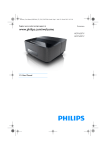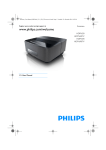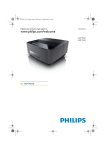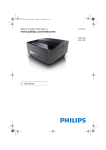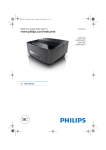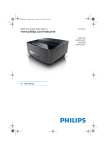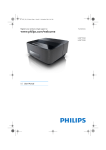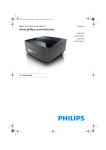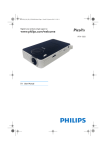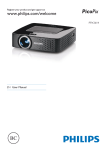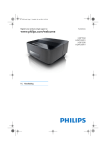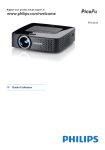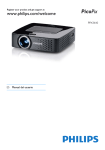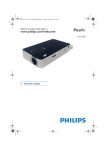Download Philips HDP1690
Transcript
Screeneo_User-Manual_HDP16x0_V1-1_EN-US_253634032-A.book Page 1 Jeudi, 12. février 2015 11:31 11 Register your product and get support at Screeneo www.philips.com/welcome HDP1650TV HDP1690TV US User Manual Screeneo_User-Manual_HDP16x0_V1-1_EN-US_253634032-A.book Page 2 Jeudi, 12. février 2015 11:31 11 Table on Contents Overview ...................................................3 Dear Customer ....................................................................3 About this User Manual ......................................................3 What's in the Box ................................................................3 Product Highlights ...............................................................3 1 General Safety Information ................4 Setting up the Device ..........................................................4 Automatic device temperature control ..........................4 Repairs ....................................................................................4 Power Supply ........................................................................5 Wireless Network (WLAN) .............................................5 3D glasses use .......................................................................5 Dolby Digital .........................................................................5 2 Overview ...............................................6 Front View .............................................................................6 Rear View ..............................................................................6 Remote Control ...................................................................7 Browsing the user interface ...............................................8 Overview of the Menu Functions .....................................9 Symbols in the Statusbar ....................................................9 3 Initial Operation ................................10 Setting up the Device ........................................................10 Connect Power Supply .....................................................10 Installing or Changing the batteries of the IR Remote Control ............................................................10 Using the Remote Control ..............................................11 Installing or Changing the batteries of the RF Remote Control ...........................................................11 3D glasses ............................................................................14 Initial Installation .................................................................15 4 Connect to the Playback Device ......16 Connecting to Devices with HDMI Output ................16 Connecting to a Computer (VGA) ................................16 Connecting Using an Audio/Video (CVBS) Adapter Cable ......................................................17 Connecting to a home cinema amplifier .......................17 Connecting to a Hi-Fi unit ...............................................17 Connecting the headphones ............................................18 WiFiDisplay (Miracast) ......................................................18 Directly Connecting Projector to Computer using WLAN (WiFi Streaming) .......................................18 ScreeneoWLink software ................................................18 5 Memory ...............................................21 Inserting a Memory Card .................................................21 Connecting USB Storage Medium ..................................21 6 Network ..............................................22 LAN Network ....................................................................22 Wireless Network (WLAN) ...........................................22 Switching Wireless Networking (WLAN) on/off .......23 Setting up a Wireless Network (WLAN) ....................23 Setting up a Wireless Network (WLAN) using the Wizard ................................................................ 23 Wifi Hotspot ....................................................................... 24 Digital Living Network Alliance (DLNA) ..................... 25 7 Bluetooth ........................................... 26 Activating the Bluetooth connection ............................ 26 Setting up Bluetooth parameters ................................... 26 Bluetooth speaker ............................................................. 26 8 Media Playback .................................. 28 Navigating in the media Playback ................................... 28 Video playback .................................................................... 29 Photo Playback ................................................................... 29 Music Playback .................................................................... 31 Managing Files ..................................................................... 32 9 Digital TV Playback (Depending on model) ........................... 33 Connecting the Aerial ...................................................... 33 First Playback ...................................................................... 33 Television ............................................................................. 34 Modifying the DVB-T settings ......................................... 34 10 Android ............................................... 35 Starting Android Apps ...................................................... 35 Exiting Android .................................................................. 35 Installing Android-Apps .................................................... 35 11 Settings ............................................... 36 Overview of the Menu Functions .................................. 36 12 Service ................................................ 38 Cleaning ............................................................................... 38 Device Overheated ........................................................... 38 Update Firmware with Memory Card .......................... 38 Troubleshooting ................................................................. 39 13 Appendix ............................................ 41 Technical Data .................................................................... 41 Accessories ......................................................................... 41 Screeneo_User-Manual_HDP16x0_V1-1_EN-US_253634032-A.book Page 3 Jeudi, 12. février 2015 11:31 11 Overview Dear Customer What's in the Box Thank you for purchasing our projector. We hope you enjoy your device and its many functions! 1 – Projector 2 – Remote Control (with 2AAA battery) 3 – A/C power cable 4 – USB - Mini USB Cable for charging 3D glasses 5 – 3D Glasses with a quick start guide, a warning label and a protection bag (depending on model) 6 – Quick Start Guide 7 – Warranty Guide 8 – Bag About this User Manual With the installation guide on the following pages, you can start using your device quickly and easily. Detailed descriptions can be found in the following sections of this user manual. Read the entire user manual carefully. Follow all safety instructions in order to ensure proper operation of your device. The manufacturer accepts no liability if these instructions are not followed. This user manual describes several versions of the product. An infrared remote control (IR) is provided with the HDP1650 and HDP1650TV models. A radio frequency remote control (RF) is provided with the HDP1690 and HDP1690TV models. a b GUIDE SOURCE AMBILIGHT 3D TV FORMAT SMART TV LIST INFO c OK OPTIONS EXIT CH - CH + 1.@ 2 ABC 4 GHI 7 PQRS SUBTITLE DEF 3 5 JKL MNO 6 8 TUV WXYZ 9 0 d TEXT PHILIPS e f g h Symbols Used Notice Troubleshooting This symbol designates tips that will help you to use your device more effectively and easily. CAUTION! Damage to the Device or Loss of Data! This symbol gives warning of damage to the device and possible loss of data. This damage can result from improper handling. DANGER! Product Highlights Connecting to devices with HDMI output With a HDMI cable you can connect the projector to a computer or laptop (see Connect to the Playback Device, page 16). WiFiDisplay (Miracast) With the Miracast™ solution you can display video between Wi-Fi devices, without cables or a network connection. You can do things like view pictures or videos from a smartphone or laptop on your projector. Danger to Persons! This symbol gives warning of danger to persons. Physical injury or damage can result from improper handling. 3 Screeneo_User-Manual_HDP16x0_V1-1_EN-US_253634032-A.book Page 4 Jeudi, 12. février 2015 11:31 11 1 General Safety Information Do not make any changes or settings that are not described in this user manual. Physical injury or damage to the device or loss of data can result from improper handling. Take note of all warning and safety notes indicated. Do not expose the device to extreme vibrations. It may damage the internal components. Do not allow children to handle the device without supervision. The packing materials should be kept out of the hands of children. Setting up the Device Automatic device temperature control The unit is for indoor use only. The device should be placed securely on a stable, flat surface. Position all cables in such a way that no one will stumble on them, thus avoiding possible injuries to persons or damage to the device itself. Do not plug in the device in moist rooms. Never touch the mains cable or the mains connection with wet hands. The device must have sufficient ventilation and may not be covered. Do not put your device in closed cabinets or boxes. Do not place the machine on soft surfaces such as tablecloths or carpets and do not cover the ventilation slits. Otherwise the device could overheat or catch fire. Protect the device against direct sunlight, heat, large temperature fluctuations and moisture. Do not place the device in the vicinity of heaters or air conditioners. Observe the information on temperature and humidity in the technical data. Do not allow liquids to enter into the device. Switch off the device and disconnect it from the mains supply if liquids or foreign substances end up inside the device. Have the unit inspected by a technical service department. Always handle the unit with care. Avoid touching the lens. Never place heavy or sharp objects on the projector or the power cable. If the projector gets too hot or emits smoke, shut it down immediately and unplug the power cable. Arrange for your device to be investigated by a technical service centre. To prevent the spread of fire, open flames should be kept away from the device. Under the following conditions, a layer of moisture can appear inside the device which can lead to malfunctions: • if the device is moved from a cold to a warm area; • after a cold room is heated; • when this device is placed in a damp room. This device include an automatic thermal management controller. If the internal temperature gets too hot, the Fan speed will automatically increase (noise increase), if the temperature still continue to growth, the brightness of your product will decrease and in worst case the current symbol will appear. The product will automatically switch off the display after displaying this message during 5s. This kind of behaviour should not arrive except if the outside temperature is very high (>35°C). In such case return the product to the manufacturer would be recommended. Repairs Do not repair the device yourself. Improper maintenance can result in injuries or damage to the device. Your device must be repaired by an authorised service centre. Find details of authorised service centres on the warranty card. Do not remove the type label from your device; this would void the warranty. Proceed as follows to avoid any moisture build-up: 1 Seal this device in a plastic bag before moving it to another room, in order for it to adapt to room conditions. 2 Wait one to two hours before you take the device out of the plastic bag. The device should not be used in a very dusty environment. Dust particles and other foreign objects may damage the unit. 4 Philips · HDP16x0 & HDP16x0TV Screeneo_User-Manual_HDP16x0_V1-1_EN-US_253634032-A.book Page 5 Jeudi, 12. février 2015 11:31 11 Power Supply Before turning on your device, check that the outlet that you are going to plug it into conforms to the indications shown on the information plate (voltage, current, power network frequency) located on your device. This device shall be connected to a single phase power network. The device shall not be installed on bare ground. Only use the power cable that is supplied with your device. Your device is delivered with a grounded power cord. It is imperative to connect a grounded connector to a grounded outlet connected to the building earthing. The socket outlet shall be installed near the equipment and shall be easily accessible. The product should be supplied by a power system compliant with LPS requirements of 2.5 of UL60950-1. In case of failure, the power cable is the disconnect device for this equipment. To remove all electrical power from the equipment, disconnect the power cable from the electrical outlet. Turn off the device and unplug from the power outlet before cleaning the surface. Use a soft, lint-free cloth. Never use liquid, gaseous or easily flammable cleansers (sprays, abrasives, polishes, alcohol). Do not allow any moisture to reach the interior of the device. • how to make a proper and regular cleaning and disinfection in the case of any particular eventualities-ocular infections, infestations of the head, mixed use, etc... where disinfection of the glasses is not possible as it may damage the functionality of the 3D glasses must be communicated to the consumer that in presence of these eventualitiesinfections is contraindicated the use of 3D glasses for the person concerned until the disappearance of the above circumstances; • 3D glasses must be kept out of children if there is the presence of small moving parts ingestible; • 3D glasses are to be used together with the instruments of vision correction in case the consumer is the bearer of lenses (eyeglasses or contact lenses); • You should stop watching 3D in the event of the occurrence of eye problems or discomfort, and in the event of a persistence of the same, consult a doctor. Dolby Digital Manufactured under license from Dolby Laboratories. Dolby and the double-D symbol are trademarks of Dolby Laboratories. DANGER! High Power LED This device is equipped with high power LED (Light Emitting Diode), which emit very bright light. Do not look directly into the projector lens. This could cause eye irritation or damage. Wireless Network (WLAN) The functioning of security systems, medical equipment or sensitive devices can be disrupted by the transmission power of the device. Observe any usage regulations (or restrictions) in the vicinity of such equipment. The use of this device can affect the operation of insufficiently shielded medical devices and hearing aids and pacemakers through the release of high frequency radiation. Also consult a doctor or the manufacturer of the medical device to establish whether these are sufficiently shielded from external high frequency radiation. 3D glasses use The use of 3D glasses in home for watching TV shows: • is contraindicated for children less than 6 years old; • for children from 6 years old to adulthood, should be limited to the vision for a maximum time equal to the duration of a film show; • the same time limit is also recommended for adults; • must be restricted to watching only 3D content; General Safety Information 5 Screeneo_User-Manual_HDP16x0_V1-1_EN-US_253634032-A.book Page 6 Jeudi, 12. février 2015 11:31 11 2 Overview Front View Rear View 1 Control panel for navigation and operation u – To display the home menu ¿ – One menu step back, one directory level back / cancelling a function //À/Á – Navigation keys / navigate the menu / modify settings – Confirms selection B– Long press: Power off the projector Short press: ECO mode on / off 2 Ï – Audio output – headphone connection or connection for external speakers 3 3– HDMI port for a playback device 4 – Memory card slot 5 ý – USB port for a USB storage medium or to connect accessories (mouse or keyboard). 6 Focus wheel for image sharpness 1 – Power supply outlet 2 ý – 2 USB ports for a USB storage medium 3 – Digital audio connector 4 – HDMI 1 and 2 ports for a playback device 5 Kensington Security System Connector 6 VGA – Personal Computer input 7 – LAN network connector 8 – Analog audio connectors 9 / – A/V port for a playback device – Remote screen connection – Aerial socket for TV connection – Lens a PHILIPS S/PDIF OPTICAL a b 6 f PHILIP S c d e b c d e 1 2 VGA L R AUDIO OUT f g AV IN TRIG OUT j i h Philips · HDP16x0 & HDP16x0TV Screeneo_User-Manual_HDP16x0_V1-1_EN-US_253634032-A.book Page 7 Jeudi, 12. février 2015 11:31 11 3 EPG –To display the electronic program guide. 3D – To display the 3D menu. Favorite – To display the favourite list in DVB-T mode. Remote Control 4 To display the home menu. 5 TAB key or Toggle between TV and Radio channels in DVB-T mode and browsing the Internet without external keyboard. a b c 6 Navigation keys – Confirms selection /, À/Á – Navigation keys / navigate the menu / modify settings. / 7 EXIT – One menu step back, one directory level back / cancelling a function. d e f g MENU TAB 8 PAGE/CH- PAGE/CH+ –To select the previous channel/page or the next channel/page. 9 Color keys - On-screen options. Number keys and text keypad. Short press for numbers and long press to switch "letters" SUB/SHIFT – To display subtitles in DVB-T mode or shift key in input mode. I TTX/← – To display Teletext pages when available in DVB-T mode or backspace key in input mode. h / / – / + – To adjust the volume level (to decrease/increase and to mute the sound). i RECALL – To recall the last function or the last channel viewed in DVB-T mode. OPTIONS – To call the option menu. j INFO – To display program information on current program in DVB-T mode. SUB/SHIFT MENU – To display the settings menu in DVB-T mode. SOURCE – To display the list of input connections. SMART SETTINGS – To display the Smart settings menu FORMAT – To change the aspect ratio. 1 Long press: Power off the projector. Short press: Power on the projector or ECO mode on/off. To power the projector on use the B key on the control panel For radio frequency remote control (RF), a QWERTY keyboard is available below for you to enter text easily. 2 Playback keys – Skip backward (music only) – To stop playback TAB – Skip forward (music only) – To rewind – To start / pause playback – To fast-forward Overview 7 Screeneo_User-Manual_HDP16x0_V1-1_EN-US_253634032-A.book Page 8 Jeudi, 12. février 2015 11:31 11 Browsing the user interface Navigation for setting menu Infrared Remote Control (IR) Navigation can be done by navigation keys (,, À,Á, OK and ¿) on the control panel or the remote control, as well as by an air mouse. Navigation by keys: • / scrolls trough the menu level up and down. • OK/Á goes one level down, with À / ¿ one level up. • u goes back to the main screen. • In the final level, accepts a setting and goes back to the last sub menu. • The ¿ key aborts a setting and goes back to the last sub menu (or exits the menu depending on which menu) Radio freqency Remote Control (RF) If there are more menus listed than displayed you can scroll the list by clicking into the list and move up and down without releasing the left mouse button. With the right mouse key you can exit the menu and go back to the next top level menu. Software Keyboard Notice To enter text, you can also use standard computer keyboard or mouse. It is possible to use wired models (USB) as well as wireless models with 2.4 GHz USB-connectors. When you need to enter data, the projector displays a virtual keyboard which allows you to enter text, numbers and punctuation marks, etc. 1 Select the input field using the ,,À and Á keys, then press the OK key to display the keyboard or click in the input field using the air mouse. 2 The software keyboard appears. 3 Enter the text on the software keyboard. To use the RF remote control you must connect the supplied receiver into a USB port, refer to the chapter “Initial Operation” page 10. For activate the mouse touch and hold the OK button until the pointer on the screen appears. Select an icon by pointing with the pointer and clicking with the OK key of the remote control. Navigation by keys: • / scrolls trough the menu level up and down. • OK/Á goes one level down, with À / ¿ one level up. • u goes back to the main screen. • In the final level, accepts a setting and goes back to the last sub menu. • The ¿ key aborts a setting and goes back to the last sub menu (or exits the menu depending on which menu) To use the QWERTY keyboard • ,,À and Á scrolls trough the menu. • ENTER/Á goes one level down, with À one level up. • Fn to use blue characters Navigation by (air) mouse: (like standard mouse operation within Android) CAUTION! Air mouse The air mouse is not provided with Screeneo HDP1650TV. Select an icon by pointing with the mouse pointer and clicking with the left mouse key. 8 Philips · HDP16x0 & HDP16x0TV Screeneo_User-Manual_HDP16x0_V1-1_EN-US_253634032-A.book Page 9 Jeudi, 12. février 2015 11:31 11 Overview of the Menu Functions Symbols in the Statusbar 1 After switching on the device the main menu appears. 2 Select the desired menu using the navigation keys /, À/Á. 3 Confirm with OK. 4 By pressing the u key you will return to the main menu. a b c de 1 – Time 2 – Date 3 – LAN status display 4 – Bluetooth status display 5 – WiFi status display HDMI 1, 2, & 3 – Switch to the external video input HDMI. TV1 – Television DLNA – Displays the list of the devices found on the Network. Memory – Display the content of the internal memory and the inserted memory SD-Card (movies, pictures, musics, folderview). USB – Display the content of the connected USB media (movies, pictures, musics, folderview). WWW – Open an Internet web browser. VGA – Switch to the Personal computer input. A/V-in – Switch to the Audio Video input. APPs – Call the android operating system. Settings – Configure settings for the wished used of the device. 1.Depending on the device model, TV can be replaced by BT speaker. Overview 9 Screeneo_User-Manual_HDP16x0_V1-1_EN-US_253634032-A.book Page 10 Jeudi, 12. février 2015 11:31 11 3 Initial Operation Setting up the Device Before installing your device, make sure that the projector is turned off and the power cord is unplugged from the power outlet. CAUTION! Remove protection foil before operation! Do not place any objects in front of the lens! You can position the device so that it lies flat on a table in front of the projection surface; it is not necessary to tilt it towards the projection surface. The device compensates for the distortion from the slanted projection (pincushion distortion). Check that the projection surface is appropriated to the projector. The distance between the projector and the screen determines the actual size of the image. Connect Power Supply CAUTION! The power cord is used as a power unit cut off. As a precaution, the outlet shall be located close to the device and be of easy access in case of danger. 1 Connect the power cord into the socket on the rear side of your device (1). 2 Plug the power cord to outlet on the wall (2). PHILIPS S/PDIF OPTICAL 1 2 VGA L R AUDIO OUT AV IN TRIG OUT b a To change the size of the screen, just move the projector towards or away from the wall. The size of the screen (b) is comprised between 50 and 100 inches depending on the projection distance (a), as described in the following table. 10 Diagonal size (b) (mm) [inch] Projection distance (a) (mm) 1270 [50] 108 2540 [100] 441 Installing or Changing the batteries of the IR Remote Control DANGER! Risk of Explosion with Incorrect Type of Batteries Only use the AAA type battery. There is a risk of explosion if the incorrect battery type is used. 1 To access the battery, press to unlock the locking mechanism (1) and slide out the battery compartment (2). Philips · HDP16x0 & HDP16x0TV Screeneo_User-Manual_HDP16x0_V1-1_EN-US_253634032-A.book Page 11 Jeudi, 12. février 2015 11:31 11 2 Insert the new batteries into the battery compartment with the positive and negative poles as shown. Make sure the polarities(+ and -) are aligned correctly. 3 Push the battery compartment back into the remote control until the locking mechanism engages. CAUTION! • The improper use of batteries can lead to overheating, explosion, risk of fire and injury. Leaking batteries can possibly damage the remote control. • Never expose the remote control to direct sunlight. • Avoid deforming, dismantling or charging the batteries. • Avoid exposure to open fire and water. • Replace empty batteries immediately. • Remove the battery from the remote control if not in use for long periods of time. Notice Normally the batteries will last for around one year. If the remote control stops working, please replace the batteries. If the device is not used for a long time, take out the batteries. This will prevent leakage and possible damage to the remote control. The used batteries should be disposed of according to the recycling regulations of your country. Using the Remote Control The remote control can be used within an angle of 22.5 degrees and up to 10 meters from the device. When using the remote control, no obstacle should be placed between the remote control and remote sensor. Installing or Changing the batteries of the RF Remote Control DANGER! Risk of Explosion with Incorrect Type of Batteries Only use the AAA type battery. There is a risk of explosion if the incorrect battery type is used. 1 To access the battery, take an appropriate tool and place it in the orifice as shown below, open the battery compartment. 1 PHILIPS 22, 5° EPG SOURC 3D SMART E SETTIN GS 22,5° FAVORIT E FORMA T MENU TAB INFO OK EXIT RECALL PAGE/C H- OPTION S PAGE/C H+ 1 .@ 2 4 GHI 5 JKL 7 PQRS SUBTIT LE ABC 8 TUV 0 DEF MNO 3 6 9 WXYZ TEXT PHILIPS Initial Operation 11 Screeneo_User-Manual_HDP16x0_V1-1_EN-US_253634032-A.book Page 12 Jeudi, 12. février 2015 11:31 11 2 Press the black latch locking. 3 Lift the lever blue retention. Notice Normally the batteries will last for around one year. If the remote control stops working, please replace the batteries. If the device is not used for a long time, take out the batteries. This will prevent leakage and possible damage to the remote control. The used batteries should be disposed of according to the recycling regulations of your country. 2 3 Placing the USB receiver RF Remote Control (RF) Your remote control is recognized by the device with the supplied USB receiver connected to a rear USB port.”. 4 Insert the new batteries into the battery compartment with the positive and negative poles as shown. Make sure the polarities(+ and -) are aligned correctly. 4 Notice Respect the direction of insertion, do not force any case! 1 Take the USB receiver and insert it into a USB port on the device. 5 Press the locking lever until you hear "CLICK" it tells you that the closure is correct. CLICK 5 6 Replace the battery cover in place and press down to close. 12 Philips · HDP16x0 & HDP16x0TV Screeneo_User-Manual_HDP16x0_V1-1_EN-US_253634032-A.book Page 13 Jeudi, 12. février 2015 11:31 11 2 Now do move your remote control right and left arrow moves as you move. Notice Remote Control (RF) pairing If the Screeneo does not react to RF remote control commands, the remote control has to be paired with the USB receiver again. For renewing the pairing please connect the USB receiver to a rear USB port of the Screeneo. Then pressing the red and blue key on the remote control together for 5 s to 10 s at the same time. 2 Using the RF remote control Your remote uses radio waves to communicate with your device. Notice The range of your remote control is 15 meters in direct line. 1 To activate the RF remote control, position yourself in front the camera. Touch and hold the OK button until the pointer on the screen appears. 1 Stand ye in the desired menu or setting and press OK to access. 3 When you enter the text, return your RF remote control and use the keyboard to enter your text. 3 Initial Operation TEXT_ 13 Screeneo_User-Manual_HDP16x0_V1-1_EN-US_253634032-A.book Page 14 Jeudi, 12. février 2015 11:31 11 3D glasses The 3D glasses are equipped with a battery. They have to be charged before first use. 1 Take USB mini cable (supplied), connect the USB mini on the 3D glasses and the another plug on a USB port of the device. Charging takes several hours and is complete when the LED on the glasses is on green. When the LED turns red, do a new charge. Activate 3D glasses 1 Press the ON / OFF button on the top of the glasses. 2 On the remote control, press the 3D button. 3 The 3D menu appears, select your choice and press OK. 4 Press the ON/OFF button for one second and a half on the 3D glasses . 3x 1.5 SEC The LED flashes green three times and becomes fixed. Your glasses are ready. 14 Philips · HDP16x0 & HDP16x0TV Screeneo_User-Manual_HDP16x0_V1-1_EN-US_253634032-A.book Page 15 Jeudi, 12. février 2015 11:31 11 Initial Installation ECO mode 1 To turn on the projector, push the POWER B button once. 2 Turn the device towards a suitable projection surface or wall. Note that the distance to the projection surface must be a minimum of 0.1 meter and a maximum of 0.5 meter (see Setting up the Device, page 4). Make sure the projector is in a secure position. 3 Use the focus wheel on the font of the device to adjust the image sharpness. 4 The first time you turn on the device, you should set the following settings. Press shortly the B button on the panel control or on the remote control to put the device in ECO mode. To wake up the device, press shortly again on the B button. Setting up the Language The device has already been installed. In order to change the menu language, proceed as follows: 1 Use the navigation keys to select Settings. Notice During the first installation, use OK key to validate your choice and continue to the next step, and the ¿ key to return on the previous step. 5 Use the keys / to select the language and confirm with OK. 6 Use the keys //À/Á to select the symbol + or - to set the date (day, month and year) and confirm with . 7 Use the keys / to select the date format and confirm with . 8 Use the keys / to select the time zone and confirm with . 9 Use the keys //À/Á to select the symbol + or - to set the date (hour and minute) and confirm with . 10 Use the keys / to select the time format (12h or 24h) and confirm with . 11 Use the keys / to select the location (Home or Shop) and confirm with . Home: for normal use. Shop: when you choose this option, the projector starts in demonstration mode. In this mode, the projector automatically displays the pictures or videos stored in the internal memory in loop. 2 3 4 5 6 7 8 9 Confirm with . Select Language/ Language with /. Confirm with . Select Menu Language with /. Confirm with . Select you desired language with /. Confirm with . Exit with u. Notice The demonstration mode can be activated or deactivated on the menu Setting/Maintenance/Demo mode. 12 A message is displayed «Open User Manual?», use the keys À/Á for select Yes or No. Press to continue. The manual is displayed or the address web site where the user manual can be downloaded. Turning off the projector Press the B button on the panel control of the device or on the remote control more than 5 seconds. Initial Operation 15 Screeneo_User-Manual_HDP16x0_V1-1_EN-US_253634032-A.book Page 16 Jeudi, 12. février 2015 11:31 11 4 Connect to the Playback Device Connecting to Devices with HDMI Output Connecting to a Computer (VGA) Use the HDMI cable to connect the projector to a computer, laptop or others devices. Notice Many laptops do not activate the external video output automatically when you connect a second display such as a projector. Check your laptop's manual to find out how to activate the external video output. Notice Use any of the HDMI sockets to connect the projector to a DVD player when a 3D signal is broadcasted. 1 Switch the device on using the on/off key. 2 Connect the cable to the projector's HDMI socket. Use the VGA cable (not included) to connect the projector to a computer, laptop, or some PDAs. The projector supports the following resolutions: VGA/SVGA/ XGA. For best results, please check the best resolution. PHILIPS S/PDIF OPTICAL 1 2 L VGA R AUDIO OUT AV IN TRIG OUT PHILIPS S/PDIF OPTICAL 1 2 VGA PHILIPS VGA L R AUDIO OUT AV IN TRIG OUT HDMI 3 HDMI 1 & HDM 2 3 Connect the cable to the HDMI socket of the playback device. 4 From the main menu, select HDMI 1,2 or 3 depending on the external device is connected. 1 Switch the device on using the on/off key. 2 Connect the VGA cable to the projector's VGA socket. 3 Connect the VGA plug to the VGA socket of the computer. 4 Adjust the computer's resolution to the correct setting and switch the VGA signal to an external monitor. The following resolutions are supported: Resolution Image refresh rate VGA 640 x 480 60 Hz SVGA 800 x 600 60 Hz XGA 1024 x 768 60 Hz WXGA 1280 x 768 60 Hz FULL HD 1920 x 1080 60 Hz Notice Screen Resolution For best results, please check the best resolution. 5 From the main menu, select VGA. 16 Philips · HDP16x0 & HDP16x0TV Screeneo_User-Manual_HDP16x0_V1-1_EN-US_253634032-A.book Page 17 Jeudi, 12. février 2015 11:31 11 Connecting Using an Audio/ Video (CVBS) Adapter Cable Use the projector's audio/video adapter cable (A/V cable) (not included) to connect camcorders, DVD players or digital cameras. The jacks for these devices are yellow (video), red (audio right) and white (audio left). Connecting to a home cinema amplifier Use a S/PDIF optical cable (cable not provided) to connect the DIGITAL AUDIO output on the projector to the input of your home cinema amplifier. For example, to show digital channels in DTS or DOLBY DIGITAL quality sound. PHILIPS PHILIPS S/PDIF OPTICAL 1 S/PDIF OPTICAL 2 L VGA 1 2 VGA L R AUDIO OUT AV IN R TRIG OUT AV IN AUDIO OUT S/PDIF OPTICAL AV IN TRIG OUT 1 Connect the A/V adapter to the socket of the projector. 2 Connect the video device's audio/video sockets to the A/V cable using a conventional composite video (RCA) cable. 3 From the main menu, select AV-in. Connecting to mobile multimedia devices Some video devices (e.g.: pocket multimedia players, ...) require specific connection cables. There are either supplied with the device or acquired from the manufacturer of the multimedia device. Please note that only the original cables from the device manufacturer may function. Connecting to a Hi-Fi unit It is possible to use an analog audio connection, just connect the right and left audio outputs of the Projector to the auxiliary input of your Hi-Fi system (cable not provided). PHILIPS S/PDIF OPTICAL 1 2 VGA PHILIPS L R AUDIO OUT AV IN TRIG OUT S/PDIF OPTICAL 1 2 VGA L R AV IN AUDIO OUT AV IN TRIG OUT AUDIO OUT Notice Switching to the Multimedia Device Signal Output See the multimedia device instruction manual to find out how to switch the signal output to this jack. Connect to the Playback Device 17 Screeneo_User-Manual_HDP16x0_V1-1_EN-US_253634032-A.book Page 18 Jeudi, 12. février 2015 11:31 11 Connecting the headphones 1 Before connecting the headphones, turn down the volume on the device. 2 Connect the headphones to the projector's headphone slot. The device speakers deactivate automatically when the headphones are connected. PHILIPS 3 After connecting the headphones, increase the volume to a comfortable level. DANGER! Danger of Hearing Damage Do not use the device over a longer time at high volume – especially when using headphones. This could lead to the risks of hearing damage. Before connecting the headphones, turn down the volume on the device. After connecting the headphones, increase the volume to a comfortable level. WiFiDisplay (Miracast) 7 Connect the external device (smartphone or tablet) to the same WiFi network that the projector. 8 Select on the WifiDisplay application of the external device the name of the projector connection (in the example Screeneo_5f31). 9 Connect the external device (smartphone or tablet) to the projector, it will show up connecting. 10 In the WifiDisplay application of the projector, it will show up the message Invitation to connect, Decline or Accept, select Accept. Directly Connecting Projector to Computer using WLAN (WiFi Streaming) With the ScreeneoWLink software you can connect the projector to a computer or a laptop over your wireless network. For this purpose, both devices must be connected to the same wireless network. 1 Intall the ScreeneoWlink software on your computer. The ScreeneoWlink software is stored in the Download folder, you can get it by SD card or USB disk from the address: APPs_explorer_internal flash_Download. 2 Connect the device with the wireless network (see also Wireless Network (WLAN), page 22). 3 Start ScreeneoWLink (Viewer) on your computer. 4 Click the ScreeneoWLink icon in the notification area and start the manager window. You are now able to search for projectors in the network (Search WIFI projector) and start the projection (Start projection). ScreeneoWLink software Notice Only the Miracast-certified devices can be used with this function. 1 Switch the device on using the on/off key. 2 After the initial screen the main menu appears. Notice The projector must be connected to a WiFi network. 3 4 5 6 Use the navigation keys to select APPs. Confirm with . Use the navigation keys to select WifiDisplay. Confirm with . It allows to connect the projector to a desktop PC or laptop via the wireless or wired network and to use the Screeneo as computer screen. For this, both devices must be connected to the same wireless or wired network. Screeneo firmware version 1.20 must be installed on your projector. Check the version of firmware installed on your projector by going to the Settings menu > Maintenance > Firmware version. If the Screeneo firmware version is 1.20, refer to paragraph Install the ScreeneoWLink software on my computer. If the Screeneo firmware version is less than 1.20, refer to paragraph Update the software in my projector. Notice The name used to identify the projector can be modified in the Setting menu. 18 Philips · HDP16x0 & HDP16x0TV Screeneo_User-Manual_HDP16x0_V1-1_EN-US_253634032-A.book Page 19 Jeudi, 12. février 2015 11:31 11 Update the software in my projector 20 The device turns off and on again. After around 5 minutes the Language Selection screen appears. The firmware update is now completed. You can find the Screeneo firmware version on the site « Philips »: www.philips.com/screeneo for loading the file proceed as following You must download the file on SD-card formatted FAT16 or FAT32, on USB stick or on USB digital support in order to update your Screeneo. Get yourself a suitable digital media and insert it into your computer. 1 Launch an Internet browser, in the address bar, type the address: www.philips.com/screeneo. 2 Choose your country and click on the language. 3 Click on View All 4 Products for select your model. 4 Select exactly your model with mouse. 5 In the new screen, research Support and click on. 6 The "Screeneo Smart LED projector" screen appears. In the "Software & drivers" select your language and click Download file. Notice Notice The file on the website is a zip file. It has to be unpacked and put on the root folder of the SD-card or USB-stick. 7 Depending on the browser used, save the file in the root of your digital media. 8 On the Screeneo projector, to check that it is turned off (OFF). 9 Remove the digital media on your computer and insert it into the port of Screeneo for your digital media. 10 DANGER! Inserting the digital media! Never pull out the digital media while the device is accessing it. This could cause data to be damaged or lost. Switch the device off in order to make sure that the device does not access the memory card. 11 Long press the ON/OFF button on the projector to turn it on. 12 After the initial screen, the main menu appears. Use the navigation keys to select Settings. 13 Confirm with OK. 14 Use / to select Maintenance. 15 Confirm with OK. 16 Use / to select Firmware Update. 17 Confirm with OK. 18 Use / to select Install. 19 Confirm with OK. Connect to the Playback Device If an error occurs during the firmware update process retry the procedure or contact your dealer. Copy the software on digital media (eg USB-stick) Use the USB ports on the projector to insert digital media. 1 Use / to select APPs. 2 Confirm with OK. 3 Use / to select Explorer. 4 Confirm with OK. 5 Use / to select Internal Flash. 6 Confirm with OK. 7 Use to select Download. 8 ScreeneoWLink_Setup.exe file appears in the main window. 9 Press long OK button on the remote control. 10 Use / to select Copy. 11 Confirm with OK. 12 Use //À/Á you move on to the digital media that you have connected. 13 Confirm with OK. 14 Press long OK button on the remote control. 15 Use / to select Paste. 16 Confirm with OK. 17 ScreeneoWLink_Setup.exe file is copied to the digital media. Wait that it appears in the browser window before removing the digital media projector. Install the ScreeneoWLink software on my computer 1 Insert the digital media containing the ScreeneoWLink_Setup.exe file on an appropriate port on your computer. 2 On desktop PC or laptop, select the digital media containing the file and double click the executable. 3 Follow the instructions that appear on the screen. 4 Agree to have the ScreeneWLink icon on your desktop. 5 When installation is complete, restart your computer. 19 Screeneo_User-Manual_HDP16x0_V1-1_EN-US_253634032-A.book Page 20 Jeudi, 12. février 2015 11:31 11 Link your projector and computer with WiFi 4 Click Search. Both devices must be connected to the same access point, no other network connection must be activated. As a precaution, note the name and the key to protection of your access point. On the Screeneo, Use / to select Settings. Confirm with OK. Using / select Wireless and Networks. Confirm with OK. Using / select WIFI. Confirm with OK. Using / select the desired wireless network. Confirm with OK. If your network is protected by a password, a window appears. Select the input field with the navigation buttons on the remote and press OK. A virtual keyboard appears, using the navigation keys on the remote control, witch a mouse or external keyboard. Enter your password. 10 Click Connect. 1 2 3 4 5 6 7 8 9 5 Select and click on the Screeneo where you want to connect. 6 If necessary, enter password of acces point selected. You can enjoy the Screeneo as screen for your PC. Start ScreeneoWLink on your PC 1 Open the Start menu. Locate and open the ScreeneoWLink tab. Click on ScreeneoWLink or double click on ScreeneoWLink icon of your desktop. 2 The ScreeneoWLink V1.2 software opens on the screen. 3 Stand on the projector image with the magnifying glass and click it. 20 Philips · HDP16x0 & HDP16x0TV Screeneo_User-Manual_HDP16x0_V1-1_EN-US_253634032-A.book Page 21 Jeudi, 12. février 2015 11:31 11 5 Memory Inserting a Memory Card Connecting USB Storage Medium PHILIP S PHILIP S 1 Insert a memory card with the contacts facing downwards into the / slot at the back of the device. Your device supports the following memory cards: SD/SDHC/SDXC/MMC. 2 Insert the memory card into the slot until it snaps into position. DANGER! Inserting a Memory Card! Never pull out the memory card while the device is accessing it. This could cause data to be damaged or lost. Switch the device off in order to make sure that the device does not access the memory card. 3 Press lightly on the memory card to remove it. 4 The memory card is ejected. Memory PHILIPS S/PDIF OPTICAL 1 2 VGA L R AUDIO OUT AV IN TRIG OUT 1 Connect the USB storage medium to one USB port of the device. DANGER! Inserting a Memory Card! Never pull out the memory card while the device is accessing it. This could cause data to be damaged or lost. Switch the device off in order to make sure that the device does not access the memory card. 21 Screeneo_User-Manual_HDP16x0_V1-1_EN-US_253634032-A.book Page 22 Jeudi, 12. février 2015 11:31 11 6 Network The projector can be connected to the network by a network hard-wired cable or through a wireless (Wi-Fi) connection. Use the procedure below appropriate to the type of connection you want. LAN Network Notice Connection! The LAN connection takes priority over the Wi-Fi connection. Connecting to the LAN network 1 Connect one end of a LAN cable (not supplied) to the ETHERNET port of your projector. PHILIPS S/PDIF OPTICAL 1 2 VGA L R AUDIO OUT AV IN TRIG OUT 2 Connect the other end of the LAN cable to the network. 3 Configure the LAN network settings in manual or automatic configuration. Automatic configuration The automatic configuration of the local network settings may be considered, if your local network features a DHCP or BOOTP server that can dynamically assign addresses to the peripheral devices present on the LAN. To automatically configure the local network settings: 1 Switch the device on using the on/off key. 2 After the initial screen, the main menu appears. 3 Use the navigation keys to select Settings. 4 Confirm with . 5 Using / select Wireless and Networks. 6 Confirm with . 7 Using / select Lan. 22 8 Confirm with . 9 Using / select On. 10 Confirm with . 11 Using / select Advanced. 12 Confirm with . 13 Using / select Network address. 14 Confirm with . 15 Check that Automatic is selected. Manual configuration To configure your projector manually, you should obtain the usual information used to set a peripheral device (IP address, sub-network mask, network and gateway address). To configure the local network setting manually: 1 Switch the device on using the on/off key. 2 After the initial screen the main menu appears. 3 Use the navigation keys to select Settings. 4 Confirm with . 5 Using / select Wireless and Networks. 6 Confirm with . 7 Using / select Lan. 8 Confirm with . 9 Using / select On. 10 Confirm with . 11 Using / select Advanced. 12 Confirm with . 13 Using / select Network address. 14 Confirm with . 15 Using / select Use static IP. 16 Confirm with . 17 Enter the settings IP-Address, Gateway, Netmask, DNS1 and DNS2. 18 Confirm with . Wireless Network (WLAN) In a wireless network (Wireless Local Area Network, WLAN) at least two computers, printers or other additional devices communicate with each other over radio waves (high frequency waves). Data transmission in the radio network is based on the standards 802.11a, 802.11b, 802.11g and 802.11n. Philips · HDP16x0 & HDP16x0TV Screeneo_User-Manual_HDP16x0_V1-1_EN-US_253634032-A.book Page 23 Jeudi, 12. février 2015 11:31 11 DANGER! Information on Using WLAN! The functioning of security systems, medical equipment or sensitive devices can be disrupted by the transmission power of the device. Observe any usage regulations (or restrictions) in the vicinity of such equipment. The use of this device can affect the operation of insufficiently shielded medical devices and hearing aids and pacemakers through the release of high frequency radiation. Also consult a doctor or the manufacturer of the medical device to establish whether these are sufficiently shielded from external high frequency radiation. Setting up a Wireless Network (WLAN) 1 Switch the device on using the on/off key. 2 After the initial screen the main menu appears. Infrastructure Wireless Network In an infrastructure network, multiple devices communicate via a central access point (gateway, router). All data are sent to the access point (gateway, router) and distributed from there. Switching Wireless Networking (WLAN) on/off Wireless networking is deactivated by default. You have the option of turning this function on. 1 Switch the device on using the on/off key. 2 After the initial screen the main menu appears. 3 Use the navigation keys to select Settings. 4 Confirm with . 5 Using / select Wireless and Networks. 6 Confirm with . 7 Using / select WIFI Selection. 8 Confirm with . 9 Use / to select the desired wireless network. 10 Confirm with . 11 If your wireless network is password protected, an input window appears. Select the input field (see Navigation for setting menu, page 8) using the navigation keys of the remote control and press OK. 12 Enter the password with the virtual keyboard using the navigation keys of the remote control or with an external keyboard. 13 Click on Connect. The ¿ key takes you one step back in the menu. Setting up a Wireless Network (WLAN) using the Wizard 3 Use the navigation keys to select Settings. 4 Confirm with . 5 Using / select Wireless and Networks. 6 Confirm with . 7 Using / select WIFI. 8 Confirm with . 9 Modify the settings with /. 10 Confirm with . The ¿ key takes you one step back in the menu. Network You can integrate your device very quickly and easily into an existing wireless network using Wi-Fi Protected Setup (WPS) or using a wireless network scan. Using WPS, all important settings like network name (SSID) are automatically configured and the connection protected with secure WPA Encryption. Using Wi-Fi Protected Set-up (WPS) Using Wi-Fi Protected Setup (WPS), you can integrate your device into an existing wireless network in two different ways very quickly and easily. You can activate the login with a pin code or using Push Button Configuration (PBC), if your access point (Access Point, Router) supports this method. 23 Screeneo_User-Manual_HDP16x0_V1-1_EN-US_253634032-A.book Page 24 Jeudi, 12. février 2015 11:31 11 Using WPS with Push Button Configuration (PBC) Wifi Hotspot Notice 1 Switch the device on using the on/off key. 2 After the initial screen the main menu appears. Important! The projector can work as an access point, if only a wired lan network is installed in the location of use. Use the portable Wi-Fi hotspot to share the device’s network connection with computers or other devices through the Wi-Fi network. Notice Connection! When the WiFi hotspot mode is activated, it takes priority over the other connections. 3 4 5 6 7 8 9 Use the navigation keys to select Settings. Confirm with . Using / select Wireless and Networks. Confirm with . Using / select WIFI Selection. Confirm with . Use / to select the desired wireless network.. 10 Confirm with . 11 Activate Push Button Configuration on the WLAN access point. The WLAN access point and device connect automatically and create a WPA protected connection. Activating WiFi hotspot 1 Switch the device on using the on/off key. 2 After the initial screen, the main menu appears. 3 Use the navigation keys to select Settings. 4 Confirm with . 5 Using / select Wireless and Networks. 6 Confirm with . 7 Using / select WiFi Hotspot. 8 Confirm with . 9 Using / select Portable WiFi Hotspot. 10 Confirm with . 11 Using / select On. 12 Confirm with . The projector is now visible by other Wifi devices. 24 Philips · HDP16x0 & HDP16x0TV Screeneo_User-Manual_HDP16x0_V1-1_EN-US_253634032-A.book Page 25 Jeudi, 12. février 2015 11:31 11 Setting up a WiFI hotspot To modify the WiFi hotspot name and define the security level. 1 Switch the device on using the on/off key. 2 After the initial screen the main menu appears. 3 Use the navigation keys to select Settings. Digital Living Network Alliance (DLNA) This device supports Digital Living Network Alliance (DLNA). Using this standard you can quickly interconnect your multimedia devices. Switching DLNA on and off The DLNA function is switched on by default. You have the option of turning this function off. 1 Switch the device on using the on/off key. 2 After the initial screen the main menu appears. 4 Confirm with . 5 Using / select Wireless and Networks. 6 Confirm with . 7 Using / select WiFi Hotspot. 8 Confirm with . 9 Using / select Setup WiFi hotspot. 10 Confirm with . 11 To modify the settings, use / keys to select the desired parameter. Item Description Network SSID Name of the WiFi hotspot. This is the name used to identify your projector when it is detected by another WiFi device. To modify the name, select the field and press . With the keyboard, enter the new name. Security Select among the 3 levels of security. • Open (without security) • WPA PSK • WPA2 PSK Password Select the field and press . With the keyboard, enter the new password. Show password Check the box to display the password. 3 Use the navigation keys to select Settings. 4 Confirm with . 5 Using / select Wireless and Networks. 6 Confirm with . 7 Using / select DLNA Sharing. 8 Confirm with . 9 Modify the settings with /. 10 Confirm with . The ¿ key takes you one step back in the menu. Play Media Using DLNA If DLNA enabled devices are located in the connected network, then you can access them in media playback and file management (see Media Playback, page 28). DLNA Control You can control the projector using another device (e.g. a smartphone) using DLNA. To do this, see the instruction manual for the device in question. 12 Using / select Save. 13 Confirm with . Network 25 Screeneo_User-Manual_HDP16x0_V1-1_EN-US_253634032-A.book Page 26 Jeudi, 12. février 2015 11:31 11 7 Bluetooth Activating the Bluetooth connection 1 Switch the device on using the on/off key. 2 After the initial screen, the main menu appears. 9 Using / select the desired setting. 10 Confirm with . 11 Modify the desired settings. Menu Description Select device The list shows all paired devices. Paired device To unconnect or unpair the paired device. Bluetooth speaker The projector can be used as Bluetooth speaker. In this mode, you can play music from smartphones or tablets. The projector can only connect to, and play audio from one device at a time. 3 Use the navigation keys to select Settings. 4 Confirm with . 5 Using / select Wireless and Networks. 6 Confirm with . 7 Using / select Bluetooth. 8 Confirm with . 9 Use / to select on. 10 Confirm with . The projector is now visible for the near external Bluetooth devices. Activating Bluetooth speaker Notice Bluetooth speaker connection! Depending on the model of your device, the bluetooth speaker can be activated from the main menu (BT Speaker icon) or from the APPs menu. 1 Switch the device on using the on/off key. 2 After the initial screen, the main menu appears. Setting up Bluetooth parameters 1 Switch the device on using the on/off key. 2 After the initial screen, the main menu appears. 3 Depending on model, use the navigation keys to select BT Speaker or APPs>BT Speaker. Notice 3 4 5 6 7 8 26 Use the navigation keys to select Settings. Confirm with . Using / select Wireless and Networks. Confirm with . Using / select Bluetooth. Confirm with . Remote control You can also use the SOURCE or OPTIONS key of the remote control. Press the SOURCE key and select BT Speaker or press OPTIONS key then select SOURCE and BT Speaker. 4 Confirm with OK. 5 Press the Red key to power on the speaker. Philips · HDP16x0 & HDP16x0TV Screeneo_User-Manual_HDP16x0_V1-1_EN-US_253634032-A.book Page 27 Jeudi, 12. février 2015 11:31 11 6 Press the Green key to make the speaker discoverable during 60 seconds. 7 On your external device, activate the Bluetooth connection and select the speaker name from the list. When the device is connected, his name is displayed on the top of the screen. 8 Press the Green key to play music. During music playback, the following actions are available: Red key: To stop the connection. Green key: To make a pause. Yellow key: To play the previous music. Blue key: To play the next music. Changing the name of the Bluetooth speaker connection This is the name used to identify your projector when it is detected by another Bluetooth® device. 1 Switch the device on using the on/off key. 2 After the initial screen, the main menu appears. 3 Depending on model, use the navigation keys to select BT Speaker or APPs>BT Speaker. 4 Press the Yellow key to rename the connection. 5 Use the keyboard to enter the new name. 6 Press OK to confirm. Bluetooth 27 Screeneo_User-Manual_HDP16x0_V1-1_EN-US_253634032-A.book Page 28 Jeudi, 12. février 2015 11:31 11 8 Media Playback Notice Navigation Keys All the keys shown are buttons on the remote control. Keys Action Green key of the remote control Allows to set the slide show parameters for picture files. or Allows to set the shuffle mode for music files: Notice Best Settings for Optimal Use Read the informations on the best settings in the chapter settings (see Settings, page 36) for optimal use of your device. Navigating in the media Playback To navigate in the memory media, use the following keys: Keys Action or To select folders or files in the displayed list. Á or For directories, goes one level down. For files, starts the selected media file. À or ¿ Goes one level up in the directory structure. u Exits to main screen. Red key of the remote control Allows to set the repeat mode for movie and music files: 28 • : Play mode deactivate (greyed). • : Play only the selected movie in loop. • : Play all movies in the selected directory in loop. • : Play all movies in the media in loop. • : Shuffle mode deactivate (greyed). • : Shuffle mode activate. Yellow key of the remote control Allows to display the pictures as miniatures or in a list. Blue key of the remote control Allows to delete the selected file. In order to optimize the navigation, you can select a file type on the list: • FOLDERS to view all files (photo, audio and video). • MOVIES to view videos files only. • PICTURES to view photo files only. • MUSIC to view audio files only. Philips · HDP16x0 & HDP16x0TV Screeneo_User-Manual_HDP16x0_V1-1_EN-US_253634032-A.book Page 29 Jeudi, 12. février 2015 11:31 11 Video playback Supported file formats 7 Use / to select the video file that you wish to play. Notice Supported file formats are *.avi, *.mov, *.mp4, *.mkv, *.flv, *.ts, *.m2ts, *.3gp. Video Playback (USB/SD Card/ Internal Memory/DLNA) 1 Switch the device on using the on/off key. 2 The main menu appears. Displaying Video Files Only those videos that are compatible with the projector will be displayed. 8 Press or Á to start playback. 9 Press ¿ to end the slide show and return to the overview. 10 When you press ¿ again, you will return to the main menu. Notice Navigation During Playback Review / forward: Press :/; on the remote control. Press T to stop or continue playback. 3 Use the navigation keys to select the desired media (USB, SD-card or DLNA): Memory Internal memory or SD card can be selected. USB - If only one USB key is connected the explorer shows only the content of the USB. - If more than one USB memory is connected, select the desired USB memory first. DLNA The explorer searches for servers and shows them in a list. Select the desired DLNA server. 4 Confirm with . The content of selected media is displayed. 5 To only display the movies content, select Movie using the keys /on the left of the screen. 6 Confirm with . During playback you can adjust the volume using the keys / or À/Á on the remote control. Press or repeatedly to shut off the volume completely. Photo Playback Supported file formats Supported file formats are JPEG, BMP, PNG and GIF. Photo Playback (USB/SD Card/ Internal Memory/DLNA) 1 Switch the device on using the on/off key. 2 The main menu appears. Notice The use of color keys The Red key allows to set the repeat mode: • : Play mode deactivate (greyed). • : Play only the selected movie in loop. • : Play all movies in the selected directory in loop. • : Play all movies in the media in loop. The Blue key alows to delete the selected file. Media Playback 3 Use the navigation keys to select the desired media (USB, SD-card or DLNA): SD-card Internal memory or SD card can be selected! USB - If only one USB key is connected the explorer shows only the content of the USB. - If more than one USB memory is connected, select the desired USB memory first. DLNA 29 Screeneo_User-Manual_HDP16x0_V1-1_EN-US_253634032-A.book Page 30 Jeudi, 12. février 2015 11:31 11 The explorer searches for servers and shows them in a list. Select the desired DLNA server. 4 Confirm with . The content of selected media is displayed. 5 To only display the picture content, select Picture using the keys /on the left of the screen and confirm with . Notice The use of color keys The Green key allows to set the slide show parameters. The Yellow key allows to display the pictures as miniatures or in a list. The Blue key allows to delete the selected file. 6 The list of photos are displayed on the screen as an overview. Notice Many Photos on the Memory Card or the USB Medium If there are a lot of photos on the memory card or the USB storage medium it can take a moment before the overview appears. 7 Use À/Á or / to select the image that you want to start the slide show with. 8 Press Green key to start the slide show. Notice The slide show can be started with the OK key if the parameters have already been set up. Slide Show with Background Sound 1 During the slide show, press to display the menu bar on the bottom of the screen. 2 Using À/Á select Ó. 3 Confirm with . 4 Use / to select the file that you wish to play. Notice Storage Location Only files from the internal memory/Memory Card/USB Storage Medium can be played. 5 To start the background sound confirm with . 6 Adjust the volume level with the volume keys on the remote control. 7 If no input is made, the menu bar is hidden after 5 seconds. Zoom and rotate functions During the slide show, press OK key to display the contextual menu. To perform a zoom, use the navigation keys to select the symbol then press OK. To rotate a picture, use the navigation keys to select the symbol then press OK to rotate the picture 90° clockwise. Press ¿ return to the slide show. 9 To modify the settings, use / keys to select the desired parameter. Item Description Time per slide To modify the photo display frequency. Off, 0, 2, 5, 10, 20, 30 and 60s Repeat Off, Directory or All Slide transition To modify the type of transition from one photo to another (random or by theme). Slideshow order Random or by order 10 Press Green key to start the slide show. 11 Press to pause the slide show. 12 Press ¿ to end the slide show and return to the overview. 13 When you press u, you will return to the main menu. 30 Philips · HDP16x0 & HDP16x0TV Screeneo_User-Manual_HDP16x0_V1-1_EN-US_253634032-A.book Page 31 Jeudi, 12. février 2015 11:31 11 Music Playback 5 To only display the music content, select Music using the keys /on the left of the screen and confirm with . Notice Notice Switch off the Image Playback You can switch off the screen while playing music in order to save power by a long press on the The use of color keys The Red key allows to set the repeat mode: key. Supported file formats • : Play mode deactivate (greyed). • : Play only the selected music in loop. • : Play all musics in the selected directory in loop. • : Play all musics in the media in loop. Supported file formats are MP3 and WAV. Music Playback (USB/SD Card/ Internal Memory/DLNA) 1 Switch the device on using the on/off key. 2 The main menu appears. The Green key allows to set the shuffle mode: • : Shuffle mode deactivate (greyed). • : Shuffle mode activate. The Blue key allows to delete the selected file. 6 Use / to select the file that you wish to play. 7 Press to start playback. 8 Press T to stop or continue playback. Notice 3 Use the navigation keys to select the desired media (USB, SD-card or DLNA): SD-card Internal memory or SD card can be selected! USB - If only one USB key is connected the explorer shows only the content of the USB. - If more than one USB memory is connected, select the desired USB memory first. DLNA The explorer searches for servers and shows them in a list. Select the desired DLNA server. 4 Confirm with . The content of selected media is displayed. Media Playback Navigating when Image Playback is Switched off Press / to skip to the previous or next song. Press T to stop or continue playback. Press ¿ to return to the selection. During playback you can adjust the volume using the keys / or À/Á on the remote control. Press or repeatedly to shut off the volume completely. 31 Screeneo_User-Manual_HDP16x0_V1-1_EN-US_253634032-A.book Page 32 Jeudi, 12. février 2015 11:31 11 Managing Files Delete Files You can delete files from the internal memory, the connected USB storage medium or the memory card. 1 Switch the device on using the on/off key. 2 The main menu appears. 3 Use the navigation keys to select the desired media (USB, Memory or DLNA). 4 Confirm with . 5 Use / to select the file that you want to delete. 6 Press the Blue key on the remote control to delete the file. 7 Confirm with . Notice Error If errors occur during the deletion process, make sure that the storage medium is not write-protected. 32 Philips · HDP16x0 & HDP16x0TV Screeneo_User-Manual_HDP16x0_V1-1_EN-US_253634032-A.book Page 33 Jeudi, 12. février 2015 11:31 11 9 Digital TV Playback (Depending on model) Connecting the Aerial First Playback Notice Notice Aerial Size and Orientation In some regions it is necessary to connect a larger aerial in order to grant the reception. In some countries it is necessary to point the aerial horizontally in order to grant the reception. 1 Connect the aerial to the aerial socket. Navigation Keys All the keys shown are buttons on the remote control. When the DVB-T function is first started, the automatic channel search must be started. 1 Switch the device on using the on/off key. 2 The main menu appears. PHILIPS S/PDIF OPTICAL 1 2 VGA L R AUDIO OUT AV IN TRIG OUT 3 Connect the aerial (see Connecting the Aerial, page 33). 4 Use the navigation keys to select TV. 5 Confirm with . 6 Use / to highlight a setting and use the À/ Á to select a value. - Select the country. - Select the level of the parental control. - Enter the PIN code for channel lock or parental control. Enter the code with 4 digits (0000 is not accepted) and enter again the same code to confirm. 7 Press OK to confirm the settings and continue the installation. The channel search starts automatically. 8 At the end of the search, press . Your TV is now set. You can start watching and enjoying all your channels. Digital TV Playback (Depending on model) 33 Screeneo_User-Manual_HDP16x0_V1-1_EN-US_253634032-A.book Page 34 Jeudi, 12. février 2015 11:31 11 Television Notice Navigation Keys All the keys shown are buttons on the remote control. 1 Switch the device on using the on/off key. 2 The main menu appears. 3 Use the navigation keys to select TV. 4 Confirm with OK. 5 The last viewed channel is played. Change the channel using keys CH+/CH-, / or enter directly the number with the keypad. Notice Displaying Channel Information When changing channel, channel information is displayed on the bottom projection edge. The information bar is hidden after 5 seconds. 6 Press u to end playback and return to the main menu. During playback you can adjust the volume using the keys / or À/Á on the remote control. Press or repeatedly to shut off the volume completely. Modifying the DVB-T settings To modify DVB-T settings, press the Menu key on the remote control. Main menus are: Edit channels: To display and modify the channel and radio lists. Installation: To launch an automatic or a manual search for channels. System Setup: To modify the parental lock settings, the display settings and the favorite settings. 34 Philips · HDP16x0 & HDP16x0TV Screeneo_User-Manual_HDP16x0_V1-1_EN-US_253634032-A.book Page 35 Jeudi, 12. février 2015 11:31 11 10 Android Your projector uses the Android operating system. Starting Android Apps 1 Switch the device on using the on/off key. 2 After the initial screen the main menu appears. 6 Confirm with OK. 7 Use the navigation keys to select ApkInstaller. 8 Confirm with OK. 9 Use the navigation keys to select Install. 10 Confirm with OK. 11 Navigate to the memory card and select the APK package you want to install. 12 Press OK to execute the installation package. 13 The APK package is installed. 3 Use the navigation keys to select APPs. 4 Confirm with OK. Exiting Android Press the u key to return to the main menu. Installing Android-Apps CAUTION! Trusted Sources! Apps from third party sources may be malicious. Only use installation packets from trusted sources. You can install other apps. Use the APK installation packets, proceed as follows: 1 Download the package APK and save it onto a memory card or USB-stick. 2 Insert the memory card into the device (see Inserting a Memory Card, page 21). 3 Switch the device on using the on/off key. 4 After the initial screen the main menu appears. 5 Use the navigation keys to select APPs Android 35 Screeneo_User-Manual_HDP16x0_V1-1_EN-US_253634032-A.book Page 36 Jeudi, 12. février 2015 11:31 11 11 Settings 1 Switch the device on using the on/off key. 2 After the initial screen the main menu appears. 3 Use the navigation keys to select Settings. 4 Confirm with OK. 5 Use / to select from the following settings. 6 Confirm with OK. 7 Modify the settings using OK, /, 8 Confirm with OK. The ¿ key takes you one step back in the menu. Overview of the Menu Functions Wireless and Network WiFi – switching the wireless network (WLAN) off and on. Network Selection – select the wireless network with which the device is to connect. WiFi Hot Spot – activate and deactivate WLAN tethering. LAN – switching the LAN network (LAN) off and on. Advanced – (LAN mode only) check the Network actual IP address or change the address by inputting new address. You can also select Automatic or Use static IP DLNA Sharing – switching DLNA off and on. Bluetooth – switching the Bluetooth connection off and on. Image settings 3D – set the picture modes with 2D/3D options. Keystone – use / to set the keystone. Fit Screen – use / to select the screen mode to adjust the size of your screen. Projection mode Front – normal projection; the device is located in front of the projection surface/screen Rear – rear projection; the device is located behind the projection surface; the image is reflected horizontally. 36 Front Ceiling – the device is hanging from the ceiling in an upside-down position; the image is rotated by 180 degrees. Rear ceiling – the device is located behind the projection surface, hanging from the ceiling in an upside-down position; the image is rotated by 180 degrees and reflected horizontally. Wall color correction – colour correction of the projected image to adjust to coloured projection surfaces Smart Settings – select predefined settings for brightness / contrast / colour saturation. If you modify these settings, the setting is switched to Manual. Brightness – use / to adjust the brightness and press OK to confirm. Contrast – use / to adjust the contrast and press OK to confirm. Advanced Colour temperature – set to Warm to enhance hotter colors such as red, or set to Cool to make picture bluish. Dynamic contrast – adjusts the contrast to keep it at the best level according to the brightness of the screen. Color space – to convert the color space setting to another standard. Gamma – adjusts the gamma correction according to the type of the projected image. Manual colors RGB – manually adjust the hue, saturation and brightness of colors in RGB mode. Use //À/Á to adjust the colors according to your needs. Manual colors CMY – manually adjust the hue, saturation and brightness of colors in CMY mode. Use //À/Á to adjust the colors according to your needs. Reset – valid manual modifications of colors RGB and CMY. Sound Settings: Volume – adjust the volume Deep Bass – switching the deep bass on and off Wide sound – switching the wide sound on and off Equalizer – select the equalizer mode Smart volume – turn on/off the volume level automatic control function Key beep – turn key tones on and off Speaker – switching the speaker on and off System settings Date and time – set date and time Android Settings – set Android system Philips · HDP16x0 & HDP16x0TV Screeneo_User-Manual_HDP16x0_V1-1_EN-US_253634032-A.book Page 37 Jeudi, 12. février 2015 11:31 11 Sleep mode – With this function, the projector automatically goes to ECO mode after a specified period of time or at the end of a movie. Auto Power Down (APD) – turn on/off the auto power down. The default setting is depending on the choice of: - shop mode: APD off, - dome mode on: APD off, - home mode: APD on. When the parameter is switched on, it works like this: - it should go into off mode after 3 hours. If a video is displayed, the APD should take place 3h after last user action, meaning that a pop-up will appear after 2h58 for 2 minutes, indicating that the product will go into off mode. HDMI name – select this item to change the HDMI names. Name that appears on the main screen. Language/Language Menu language – use / to select the desired language and press OK to confirm. Soundtrack – use / to select the desired language and press OK to confirm. Sub Title – use / to select the desired language and press OK to confirm. Maintenance Reset settings – Reset settings to factory defaults. Firmware Update – Update Firmware Information – Display free space in the internal memory and information on the device (Capacity: / Free space: / Firmware version: / Device name: / Model:) Demo mode – switching demo mode on and off. In this mode, Screeneo is continuously displayed on the screen and video and/or audio files placed in internal memory are read directly. Settings 37 Screeneo_User-Manual_HDP16x0_V1-1_EN-US_253634032-A.book Page 38 Jeudi, 12. février 2015 11:31 11 12 Service Cleaning DANGER! Instructions for Cleaning! Use a soft, lint-free cloth. Never use liquid or easily flammable cleansers (sprays, abrasives, polishes, alcohol, etc.). Do not allow any moisture to reach the interior of the device. Do not spray the device with any cleaning fluids. Wipe over the surfaces gently. Be careful that you do not scratch the surfaces. Cleaning the Lens 12 The device turns off and on again. After around 5 minutes the Language Selection screen appears. The firmware update is now completed. DANGER! Inserting a Memory Card! Never pull out the memory card while the device is accessing it. This could cause data to be damaged or lost. Notice If an error occurs during the firmware update process retry the procedure or contact your dealer. Use a brush or lens cleaning paper for cleaning the lens of the projector. DANGER! Do not use any Liquid Cleaning Agents Do not use any liquid cleaning agents for cleaning the lens, to avoid damaging the coating film on the lens. Device Overheated A overheat symbol appears if the device is overheated. Update Firmware with Memory Card 1 Use SD memory card in the file system FAT16 or FAT32. DANGER! All Data will be Deleted! This procedure erases all your data that is stored on the memory card. 2 Save the latest firmware update file to the root of the memory card. 3 Insert the memory card (see Inserting a Memory Card, page 21) and switch the device on. 4 Use the navigation keys to select Settings. 5 Confirm with à. 6 Use / to select Maintenance. 7 Confirm with à. 8 Use / to select Firmware Update. 9 Confirm with à. 10 Use / to select Install. 11 Confirm with à. 38 Philips · HDP16x0 & HDP16x0TV Screeneo_User-Manual_HDP16x0_V1-1_EN-US_253634032-A.book Page 39 Jeudi, 12. février 2015 11:31 11 Troubleshooting 1 Switch the device off using the on/off key on the panel control. 2 Wait at least ten seconds. 3 Switch the device on using the on/off key on the panel control. 4 If the problem repeats, please contact our technical customer service or your retailer. Power Cycling If a problem occurs that cannot be corrected with the instructions in this user manual (see also the help below), follow the steps given here. Problems Solutions The projector cannot be switched on • Disconnect and Connect the power supply cable and try again. The projector cannot be switched off • Disconnect the power supply cable. No sound • check that the speaker is activated (Settings /Sound setting/Speaker). • Adjust the volume using the remote control. • • • Check the cables to the external device Set the volume on the external device Only the original cables from the device manufacturer may function No sound from DVB-T program or external HDMI out- • put device. Set the audio setting to Multichannel (Raw data) & Stereo (PCM). No sound when you connect your computer via HDMI cable • Check that the sound is activated on the computer. Video display problem when the source is a 3D signal from a DVD player. • Check that the 3D mode is activated on the projector. If the DVD player is connected to the projector via HDMI, use any of the HDMI sockets. No sound from the external connected device • Only the initial screen appears and not the image from the external device • • • • Only the initial screen appears and not the image from the connected computer • • Service / key on the Check if the cables are connected to the right sockets. Please check that the external device is switched on Check if the video output of the external device is switched on. Check that the HDMI source selected on the user interface corresponds to HDMI connector where the external device is connected. Please check that the VGA-output of the computer is switched on. Check if the resolution of the computer is set to 1280*800(for VGA connection) or 1080P(for HDMI connection). 39 Screeneo_User-Manual_HDP16x0_V1-1_EN-US_253634032-A.book Page 40 Jeudi, 12. février 2015 11:31 11 Problems Solutions The device turns itself off • • • The device changes from maximum level of brightness to • minimum level of brightness when the device is connected over USB to play videos. • The device cannot connect with an Android device (for example a mobile phone/smartphone with the Android operating system) when connected via USB. • When the device is running for a long period of time, the surface becomes hot and a warning symbol appears on the projection (see Symbols in the Statusbar, page 9). The device automatically turns off when it gets too hot. After the device has cooled down, you can continue playback. Check that the power cable is connected correctly. Check the sleep mode status in the setting menu (). When the sleep mode is activated, the device turn off after the programmed duration. When the environment temperature is too high, the devices turns automatically from maximum level of brightness to minimum level of brightness in order to protect the high power LED. Use the device with lower environment temperatures. Deactivate the function „USB debugging“ in the settings menu of your Android device before connecting the Projector via USB; your Android device should be recognized as USB storage medium. Bad image or color quality when connecting with HDMI • Use a high quality HDMI cable. Low quality cables may cause signal distortions. The device cannot read the SD card. • Check that the memory card is compatible (see the list in the chapter Appendix). The device cannot read the USB stick • • The device does not support the exFAT file system. Format the USB key in FAT format, then use it. The TV icon doesn't appear while the DVB-T module is installed. • Call the hot-line. The projector does not react to remote control commands when using the RF remote control. • • Check if the remote control batteries are new. The remote control has to be paired with the USB receiver again. For renewing the pairing please connect the USB receiver to a rear USB port of the Screeneo. Then pressing the red and blue key on the remote control together for 5 s to 10 s at the same time. 40 Philips · HDP16x0 & HDP16x0TV Screeneo_User-Manual_HDP16x0_V1-1_EN-US_253634032-A.book Page 41 Jeudi, 12. février 2015 11:31 11 13 Appendix Technical Data Accessories Dimensions (L×H×W) .................... 287 × 148× 339 mm Weight ........................................................................... 5,3 kg Recommended Ambient......................................5 – 35 ºC Relative Humidity ................15 – 85 % (non-condensing) File format................................ *.avi, *.mov, *.mp4,*.mkv, ................................................ *.flv, *.ts, *.m2ts, *.3gp Photo formats ................................. JPEG, BMP, PNG, GIF Music formats..................................................... MP3, WAV Video Standard (CVBS)................... PAL, SECAM, NTSC Video connection .........................................HDMI sockets Internal speaker ............... stereo with subwoofer, 26 W Internal memory............................................................4 GB Compatible Memory Cards ......SD/SDHC/SDXC/MMC USB connection max. power...........................5V, 500mA Following accessories are available for your device: PVideo-(CVBS) cable.....................PPA1320 / 253526178 3D Glasses.......................................PPA5610 / 253569764 For HDP1650 an HDP1650TV models: RF remote control.........................PPA5650 / 253588194 All data are provided for reference purposes only. Sagemcom Documents SAS reserves the right to make any changes without prior notice. Technology / optical Display technology ...............................WXGA 0.45" DLP Light source ........................................................... RGB LED Native resolution......................... 1280 x 800 Pixel (16:9) Supported Resolutions..................... VGA/SVGA/WVGA ..............................................XGA/WXGA/FULL HD Projected image size (inch)...........................50 up to 100 Screen distance (mm).................................. 108 up to 441 Display refresh rate ............................. 60Hz/50Hz/120Hz Power supply Input .......................................100V-240V, 4.0 A, 50/60HZ Power consumption....................................................150W Off mode power consumption .............................. <0,5W Manufacturer .................................... JQH Group Co., Ltd. Appendix 41 Screeneo_User-Manual_HDP16x0_V1-1_EN-US_253634032-A.book Page 42 Jeudi, 12. février 2015 11:31 11 The CE marking certifies that the product meets the main requirements of the European Parliament and Council directives 1999/5/CE, 2006/95/CE, 2004/108/ CE and 2009/125/CE on information technology equipment, regarding safety and health of users and regarding electromagnetic interference. The declaration of compliance can be consulted on the site www.screeneo.philips.com. Preservation of the environment as part of a sustainable development plan is an essential concern of Sagemcom Documents SAS. The desire of Sagemcom Documents SAS is to operate systems observing the environment. The desire of Sagemcom Documents SAS is to operate systems observing the environment and consequently it has decided to integrate environmental performances in the life cycle of this products, from manufacturing to commissioning use and elimination. Federal Communications Commission (FCC) Statement: You are cautioned that changes or modifications not expressly approved by the party responsible for compliance could void the user's authority to operate the equipment. This equipment has been tested and found to comply with the limits for a Class B digital device, pursuant to part 15 of the FCC rules. These limits are designed to provide reasonable protection against harmful interference in a residential installation. This equipment generates, uses and can radiate radio frequency energy and, if not installed and used in accordance with the instructions, may cause harmful interference to radio communications. However, there is no guarantee that interference will not occur in a particular installation.If this equipment does cause harmful interference to radio or television reception, which can be determined by turning the equipment off and on, the user is encouraged to try to correct the interference by one or more of the following measures: • Reorient or relocate the receiving antenna. • Increase the separation between the equipment and receiver. • Connect the equipment into an outlet on a circuit different from that to which the receiver is connected. • Consult the dealer or an experienced radio/TV technician for help. This device complies with Part 15 of the FCC Rules. Operation is subject to the following two conditions: (1) this device may not cause harmful interference; (2) this device must accept any interference received, including interference that may cause undesired operation. 42 FCC RF Radiation Exposure Statement: This transmitter must not be co-location or operating in conjunction with any other antenna or transmitter. This equipment complies with FCC RF radiation exposure limits set forth for an uncontrolled environment. This equipment should be installed and operated with a minimum distance of 7.8 inches (20 centimeters) between the radiator and your body. Canada Regulatory Compliance: This device complies with Industry Canada CAN ICES-3 (B)/NMB3(B) RSS-Gen & RSS-210 statement: This device complies with Industry Canada licence-exempt RSS standard(s). Operation is subject to the following two conditions: (1) this device may not cause interference, and (2) this device must accept any interference, including interference that may cause undesired operation of the device. RF Radiation Exposure statement: The device meets the exemption from the routine evaluation limits in section 2.5 of RSS102 and users can obtain Canadian information on RF exposure and compliance. This equipment should be installed and operated with a minimum distance of 7.8 inches (20 centimeters) between the radiator and your body. Packaging: The presence of the logo (green dot) means that a contribution is paid to an approved national organisation to improve package recovery and recycling infrastructures. Please respect the sorting rules set up locally for this kind of waste. Batteries: If your product contains batteries, they must be disposed of at an appropriate collection point. Product: The crossed-out waste bin stuck on the product means that the product belongs to the family of electrical and electronic equipment. In this respect, the European regulations ask you to dispose of it selectively; • At sales points in the event of the purchase of similar equipment. • At the collection points made available to you locally(drop-off centre, selective collection, etc.). In this way you can participate in the re-use and upgrading of Electrical and Electronic Equipment Waste, which can have an effect on the environment and human health. The paper and cardboard packaging used can be disposed of as recyclable paper. Have the plastic wrapping recycled or dispose of it in the non-recyclable waste, depending on the requirements in your country. Philips · HDP16x0 & HDP16x0TV Screeneo_User-Manual_HDP16x0_V1-1_EN-US_253634032-A.book Page 43 Jeudi, 12. février 2015 11:31 11 Trademarks: The mentioned references in this manual are trademarks of the respective companies. The lack of the trademarks É and Ë does not justify the assumption that these dedicated terminologies are free trademarks. Other product names used herein are for identification purposes only and may be trademarks of their respective owners. Sagemcom Documents SAS disclaims any and all rights in those marks. Neither Sagemcom Documents SAS nor its affiliates shall be liable to the purchaser of this product or third parties for damages, losses, costs, or expenses incurred by the purchaser or third parties as a result of accident, misuse, or abuse of this product or unauthorized modifications, repairs, or alterations to this product, or failure to strictly comply with Sagemcom Documents SAS operating and maintenance instructions. Sagemcom Documents SAS shall not be liable for any damages or problems arising from the use of any options or any consumable materials other than those designated as original Sagemcom Documents SAS / PHILIPS products or Sagemcom Documents SAS / PHILIPS approved products. Sagemcom Documents SAS shall not be held liable for any damage resulting from electromagnetic interference that occurs from the use of any interface cables other than those designated as Sagemcom Documents SAS / PHILIPS products. All rights reserved. No part of this publication may be reproduced, stored in a retrieval system or transmitted in any form or by any means, electronic, mechanical, photocopying, recording, or otherwise, without the prior written permission of Sagemcom Documents SAS. The information contained herein is designed only for use with this product. Sagemcom Documents SAS is not responsible for any use of this information as applied to other devices. This user manual is a document that does not represent a contract. Errors, printing errors and changes are reserved. Copyright È 2015 Sagemcom Documents SAS Appendix Imported for USA / Importé pour les États-Unis / Importado para Estados Unidos P&F USA, Inc. PO Box 2248 Alpharetta, Ga 30023-2248 For further assistance, call the customer support service in your country: 1 866 310 0788 Imported for Canada / Importé pour le Canada / Importado para Canadas Bigtech 5990 14th Avenue Markham, Ontario L3S 4M4 Pour obtenir de l’aide supplémentaire, communiquez avec le centre de service à la clientèle de votre pays : 1 866 310 0788 Exclusivo para México. For Mexico only. Exclusivement pour le Mexique PROYECTOR (Screeneo) Alimentación: 100 – 240V ~ 50/60Hz 4A Consumo de Energía Eléctrica 150 Wh Consumo de Energía Eléctrica del aparato en Modo de Espera < 0,5 Wh Importador: P&F Mexicana. S.A. de C.V. Av. La Palma No 6. Col. San Fernando La Herradura Huixquilucan. Edo. de México. MEXICO C.P. 52787 Tel 52 (55) 52699000 EXPORTADOR: P&F USA INC. HECHO EN CHINA GARANTIA INCLUIDA EN EL INSTRUCTIVO DE USO MODEL N° (i.e. HDP1690/F7) 43 Screeneo_User-Manual_HDP16x0_V1-1_EN-US_253634032-A.book Page 43 Jeudi, 12. février 2015 11:31 11 PHILIPS and the PHILIPS’ Shield Emblem are registered trademarks of Koninklijke Philips N.V. and are used by Sagemcom Documents SAS under license from Koninklijke Philips N.V. È 2015 Sagemcom Documents SAS All rights reserved Sagemcom Documents SAS Documents Business Unit Headquarters : 250, route de l’Empereur 92848 Rueil-Malmaison Cedex · FRANCE Tel: +33 (0)1 57 61 10 00 · Fax: +33 (0)1 57 61 10 01 www.sagemcom.com Simplified Joint Stock Company · Capital 8.479.978 € · 509 448 841 RCS Nanterre HDP16x0TV EN-US 253637294-A












































